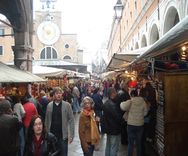
|

RIALTO
Rialto was the first inhabited part of what
now is known as the city of Venice. The Government of the "Serenissima"
was formerly headquartered in Malamocco but was moved to the Realtine
Islands during the age of doge Agnello Partecipazio (810-827). This
event occurred as a result of the threat posed by Pepin the Short
who tried to invade the lagoon in 810. Only at the beginning of the
13th century the name of the city changed from Civitas Rivoalti to
Civitas venetiarum, similar to the name universally known as Venice.
The name Rialto derives from the fact that in that vast area the banks
of the canals were higher than the average of other islands, much more
prepared to be inhabited. The center of power was then transferred to
the Doge's Palace in 814 while the area of Rialto, (Rivoaltum), became the
center of commerce in the city.
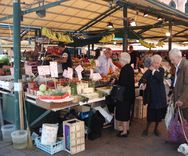
The first product to be exchanged at Rialto was the salt,
as it was produced in the lagoon. For centuries
the "Serenissima" had the monopoly exporting salt to the Po Valley. It was then
the turn of sugar and pepper, the last one considered the "black gold"
of the Middle Ages. At Rialto then came the spices from the Middle
East such as nutmeg, ginger, saffron and many others. In the market
it was sold camphor, incense and opium. These businesses made the good
fortune of Venetian merchants for centuries, until the
Spanish and Portuguese opened the route to the Americas in the 16th
century, marking the decadence of the Republic of Venice. Near
the Rialto for over 400 years it held the slaves market,
abolished in the 16th century, yet.
Osterie Rialto (Taverns)
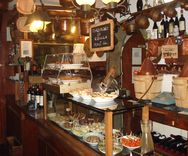
The meaning of the word "osteria" has changed recently. Until
a few years ago in the osterie you could see the older men play cards
and drink a glass of wine. Currently the new osterie are very similar
to real restaurants. Those located in the Rialto area instead offer
a truly ancient Venetian atmosphere, providing good wine and "cicchetti"
(toothpicks). These properties offer the great opportunity to stand
next to the real Venetians while they are taking a break with friends after
a walk in the Rialto Market.
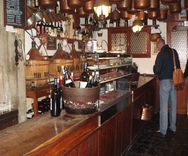
"Cantina do Mori" - S. Polo 429, Calle Galliazza, Rialto,
tel. +39 041 5225401. Good wines and fine cicchetti. Opening hours 8,30am-8pm, closes on Sunday.
"Osteria ai Storti" - S. Polo 819, Rialto, telephone +39 041 2412255.
Venetian plates. Open 8am-10pm, closed Monday.
"Osteria alla Ciurma" - Rialto 406, phone +39 041 5239514. Open daily, 8am-10pm.
"Osteria all'Arco" - Calle de l'Ochialer 436, tel. +39 041 5205666. Open 7am-5pm, closed Sunday.
"Osteria al Diavolo e l'Acquasanta" - Calle de la Madona 561, Rialto,
telephone +39 041 2770307. Opening hours 12am-9,30pm, closed on Monday afternoon and Tuesday.
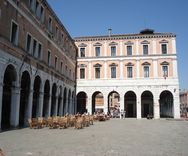
In the Rialto area in ancient times there were more than 200 inns,
hotels and taverns, testifying as this was the true heart of the city.
In places such Erbaria and Naranzaria were sold fruits and vegetables
that came mostly from the islands of the lagoon (S. Erasmo, Vignole).
In Rialto is naturally sold fresh fish caught in the lagoon
or in the Adriatic Sea. Currently, the Fish Market opens from 7,30am
to 12,00am, Tuesday-Saturday, while the Rialto Market of fruit and
vegetables has following schedule: 7,30am-1,30pm from Monday
to Saturday. In ancient times also arrived here the wine from overseas
(particularly required was the "Malvasia"). In memory still exists along
the Grand Canal the "Riva del Vin" (Wine Waterfront), In S. Giacometto
Square opened the first insurance companies (which ensured the ships
traveling to and from the East) and the "Bancogiro". It was due to
the trade managed in this area that the national currency, the "Zecchino
d'Oro", became the most valuable currency in the Mediterranean, comparable
to the importance of actual currencies like Euro and Dollar.
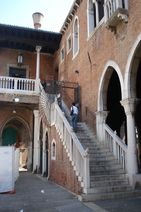
How getting to Rialto? You can walk or take the ferry (vaporetto).
From the train station you can walk down the Lista di Spagna and then
along the Strada Nuova to Campo Santi Apostoli, from here you need
another 5 minutes to reach easily Rialto, (near the Ca 'd'Oro, in
Campo Santa Sofia, is available the gondola ferry that crosses the
Grand Canal to the Market, fare 0.50 euro per person). Walking
from the station should be considered an interesting itinerary
through an old part of the city, the district of Santa Croce: crossing
the Ponte degli Scalzi and then along the Rio Marin - Campo Nazario Sauro
- Campo S. Giacomo da l'Orio - Campo S. Canciano, we reach the Fish Market
in less than a 30-minute walk (just follow the directions on a black
background with yellow arrow). Would you like to take a walk
from Piazzale Roma to Rialto? Go to the Frari Square and then to Campo
San Polo, in another 5 minutes you will get in Rialto area and you will cross
the district (sestiere) of S. Polo in about 25 minutes. To reach Rialto
from St. Mark's Square, walk along "Mercerie", a road often crowded and
full of shops, perfect for enthusiasts of shopping. To go by vaporetto
to Rialto from
Piazzale Roma or from the station are availabile the waterbus lines 1
and 2 provided by Actv.
Restaurants in Rialto
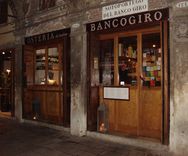
"Osteria Bancogiro" - San Polo 122, just 50 meters
from the church of S. Giacometto in Rialto, telephone +39 041 5232061.
It has available some tables overlooking the Grand Canal. Opening hours: 10,30am-12pm,
closed on Monday.
"Restaurant Vecio Fritolin" - Santa Croce 2262, Calle della
Regina, three-minute walk from Rialto, tel. +39 041 5222881.
Quiet, perfect for a romantic dinner. Specialty seafood dishes:
scallops with scalded cream with asparagus, spaghetti with
zucchini and squills. Open 12am-2,30pm and 7pm-10,30pm, closed on Monday.
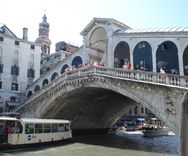
The Rialto Bridge was built for the first time in 1180 by
Nicolò Barattieri and was a bridge made by boats over the boards to allow the
transit, then was called the "Quarterolo", because of currency
payed for transit. It was rebuilt in 1265 but this
time made in wood and again in 1310. Following a collapse in 1444 was
rebuilt with a drawbridge that would allow the passage of vessels
with high tree, (witnessed by a picture of Carpaccio, "The Miracle
of the Relic of the Cross", still visible inside of the
Accademia Galleries). After much controversy it was finally decided to build
it in stone; it was held a public competition (which also participated the
celebrated architect Palladio with a project), but won the proposal
made by Antonio da Ponte. The construction of the magnificent Rialto
Bridge began in 1588 and was carried out in 1591. Until the 1854, when
it was built the Accademia Bridge, the Rialto Br. was the only one
to cross the Canal Grande.
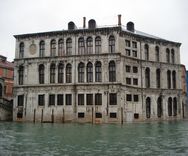
The Palazzo dei Camerlenghi (Palace of Chamberlains) is located between the
Rialto Bridge and the Grand Canal. This Renaissance-style building was built
for the will of the doge Andrea Gritti between 1525 and 1528 (project by William
de Grigis called Bergamasco). This Palace in Rialto is divided into three
floors and housed at the age of the Serenissima the Camerlenghi that were
financial magistrates. Inside were visible until 1806 the paintings with portraits
of officials who had exercised their duties. Today this building houses the headquarters
of the Corte dei Conti (S. Polo, 1 Rialto, phone +39 041 2704911).
Budget hotel in Venice
|